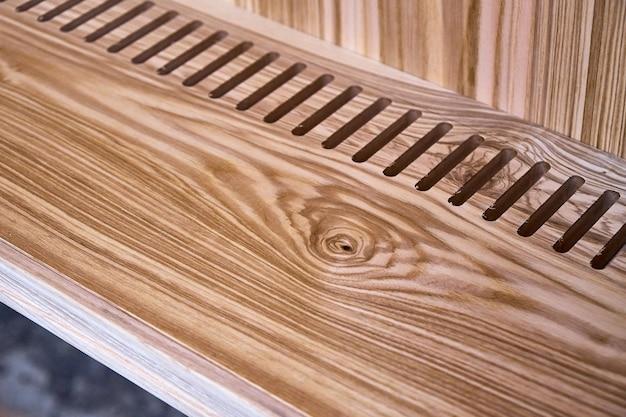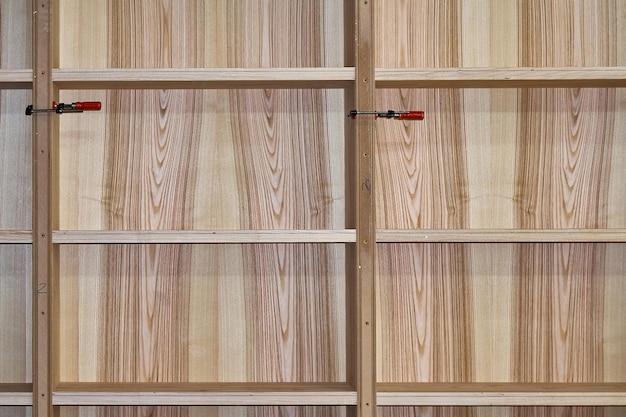Manufactured boards, such as plywood and MDF (medium-density fiberboard), have become increasingly popular in the world of furniture and construction. But have you ever wondered why these boards are often veneered? In this blog post, we will delve into the reasons behind this practice and explore the advantages of manufactured boards over solid timber.
Veneering is the process of covering the surface of a manufactured board with a thin layer of real wood, often called a veneer. This practice serves several purposes. Firstly, veneering enhances the visual appeal of the board, giving it a beautiful, natural wood grain and texture. Additionally, the veneer provides a protective layer that helps to prevent damage, such as scratching or warping, to the underlying manufactured board.
So why do we choose manufactured boards over solid timber in the first place? Well, they offer several advantages. Manufactured boards are often less expensive than solid timber, making them a more cost-effective option. They also tend to be more stable and resistant to warping, thanks to their engineered structure. Furthermore, the manufacturing process allows for greater flexibility in terms of size, shape, and strength, making manufactured boards suitable for a wide range of applications, including flat pack furniture.
In the sections to follow, we will explore these concepts in more detail and answer common questions like what is the cheapest type of plywood and what is the strongest board? We will also discuss why it is necessary to cover the edges of manufactured boards. So, let’s dive into the world of manufactured boards and veneering to understand why they have become so popular in modern construction and design!

Why are Manufactured Boards Veneered?
Manufactured boards, also known as engineered wood or composite wood, have become increasingly popular in the construction and furniture industries. These boards are made by utilizing a combination of wood fibers, adhesives, and other materials to create a strong and versatile product. One common practice in manufacturing these boards is to apply a veneer, which is a thin layer of decorative wood, onto the surface. Now, you might be wondering, why on earth do they do that? Well, let’s dig deeper and uncover the reasons behind this peculiar practice.
Enhancing Aesthetics and Appeal
Veneering is like putting makeup on these boards. It helps to enhance their appearance and provide a touch of elegance. By applying a thin layer of high-quality wood veneer, manufacturers can give the manufactured boards the look of solid wood. This means you can enjoy the beauty and natural grain patterns of wood without the hefty price tag. So, next time you marvel at the gorgeous wooden furniture in your home, remember it might just be manufactured board with a thin layer of veneer!
Protecting the Core
But wait, there’s more! Veneering not only adds visual appeal but also acts as a protective shield for the core of the manufactured board. The core of these boards is usually composed of lower-quality wood fibers or particles, which might not have the same durability as solid wood. By adding a layer of veneer, manufacturers can safeguard the core from moisture, scratches, and other potential damage. It’s like giving the board a cozy little wooden armor, ensuring it stays in tip-top shape for years to come.
Versatility and Flexibility
One of the greatest advantages of using manufactured boards is their versatility. These boards can be designed and produced to meet specific requirements, making them ideal for various applications. And guess what? Veneering plays a significant role in enhancing this versatility. Since veneers can be made from different types of wood, manufacturers have the freedom to select the veneer that best suits their desired aesthetic and functional needs. It’s like having a vast array of fashionable outfits to dress up your furniture!
Environmentally Conscious Choices
Another key factor driving the trend of veneered manufactured boards is sustainability. By using veneers, manufacturers can make the most out of finite resources. Since veneers are made by slicing thin layers from a solid piece of wood, one log can produce multiple sheets of veneer. This not only reduces the demand for solid wood but also minimizes waste. So, when you opt for furniture made from veneered manufactured boards, you can feel good about making an environmentally conscious choice.
Manufactured boards have revolutionized the furniture and construction industries, offering durability, affordability, and versatility. By applying veneers to these boards, manufacturers can enhance their appearance, protect the core, and create a sustainable product. So, the next time you admire the beautiful veneered furniture in your home, remember that there’s more to it than meets the eye. It’s a marriage of style, functionality, and environmental consciousness – all thanks to the intriguing practice of veneering.

FAQ: Why are Manufactured Boards Veneered?
Why Are Manufactured Boards Veneered
Manufactured boards, such as plywood and particleboard, are often veneered for several reasons. These thin layers of real wood provide both aesthetic and practical benefits. Let’s take a closer look at why veneering is commonly used in the production of manufactured boards.
Aesthetic Appeal
Manufactured boards are typically made up of layers or particles of wood that are bound together with adhesive. While these boards are sturdy and cost-effective, they may not have the same visual appeal as solid timber. Veneering solves this problem by adding a thin layer of genuine wood to the surface, giving the manufactured board a more refined and attractive appearance.
Cost Efficiency
Solid timber can be expensive, especially when it comes to larger projects or custom-made furniture. Manufactured boards offer a more cost-efficient alternative. By using a thin layer of wood as a veneer, manufacturers can enhance the appearance of the board without using excessive amounts of expensive solid timber.
Stability and Durability
Manufactured boards are engineered to be stable and resistant to warping or twisting, unlike solid timber that can be prone to these issues. By applying a veneer to the surface, manufacturers further enhance the stability and durability of the board. The veneer acts as a protective layer, helping to prevent moisture absorption and providing additional strength.
What Advantages Do Manufactured Boards Have Over Solid Timber
Manufactured boards offer several distinct advantages over solid timber, making them a popular choice for a variety of applications.
Versatility and Consistency
Manufactured boards are available in a wide range of thicknesses, sizes, and grades, allowing for greater design flexibility and consistency in construction projects. Unlike solid timber, which can vary in grain pattern and quality, manufactured boards provide a more uniform and predictable material.
Environmentally Friendly
One of the most significant advantages of manufactured boards is that they help to reduce deforestation. By using smaller sections of trees or wood particles from sustainable sources, manufacturers can make more efficient use of the available resources. This sustainable approach contributes to the preservation of forests and reduces the environmental impact of furniture production.
Cost-Effectiveness
Compared to solid timber, manufactured boards are generally more affordable. The production process used to create manufactured boards allows for efficient use of wood resources, reducing waste and overall costs. This cost-effectiveness is particularly beneficial for larger construction projects or when budget constraints are a concern.
Why Are Manufactured Boards Suitable for Flat Pack Furniture
Flat pack furniture, also known as ready-to-assemble furniture, has gained popularity due to its convenience and affordability. Manufactured boards are well-suited for flat pack furniture for several reasons.
Easy Transportation and Storage
Manufactured boards are lightweight and can be easily disassembled, making them ideal for flat pack furniture. The flat pack format allows for efficient transportation and storage, reducing shipping costs and the space required in warehouses and stores.
Customizable and Adaptable
Manufactured boards are highly customizable, allowing for the creation of furniture with various shapes, sizes, and styles. These boards can be easily cut, shaped, and joined together to suit individual design preferences. This flexibility makes manufactured boards the perfect choice for flat pack furniture, which often requires assembly at home.
Strong and Durable
Manufactured boards offer excellent strength and durability, making them reliable for flat pack furniture construction. When correctly assembled, flat pack furniture made from manufactured boards can withstand regular use and provide long-lasting performance. The veneered surface adds an extra layer of protection, enhancing the furniture’s durability and aesthetic appeal.
What Is the Most Cost-Effective Type of Plywood
When it comes to cost-effective plywood options, one of the most economical choices is CDX plywood. CDX stands for “C-grade veneer on the face, D-grade veneer on the back, and exterior glue.” This type of plywood is commonly used for structural or utility purposes, such as building sheds, sheathing walls, or subflooring. While CDX plywood may not have the same appearance or smoothness as higher-grade plywood, it provides reliable strength and performance at a more affordable price.
What Is the Strongest Board
When it comes to strength, one type of manufactured board stands out from the rest: oriented strand board (OSB). OSB is made by pressing layers of wood strands together with adhesive, resulting in a dense and robust panel. Its unique construction gives OSB impressive strength and load-bearing capabilities, making it suitable for a wide range of applications, including flooring, roofing, and sheathing. If you’re looking for a board with exceptional strength, OSB is a top contender.
Why Is it Necessary to Cover the Edges of Manufactured Boards
Covering the edges of manufactured boards, such as plywood or particleboard, serves both functional and aesthetic purposes.
Protection Against Moisture
The edges of manufactured boards are typically more susceptible to moisture penetration than the surfaces. Moisture absorption can lead to swelling, warping, or delamination of the board. To prevent this, it is necessary to cover the edges with edge banding or other protective materials to create a barrier against moisture.
Enhanced Appearance
While the surfaces of manufactured boards are often veneered to improve their appearance, the exposed edges can reveal the layered construction of the board. Covering the edges with edge banding or other decorative treatments ensures a cohesive and polished look, making the board appear more like solid timber.
By covering the edges, manufacturers not only protect the board from moisture but also create a visually pleasing finished product.
